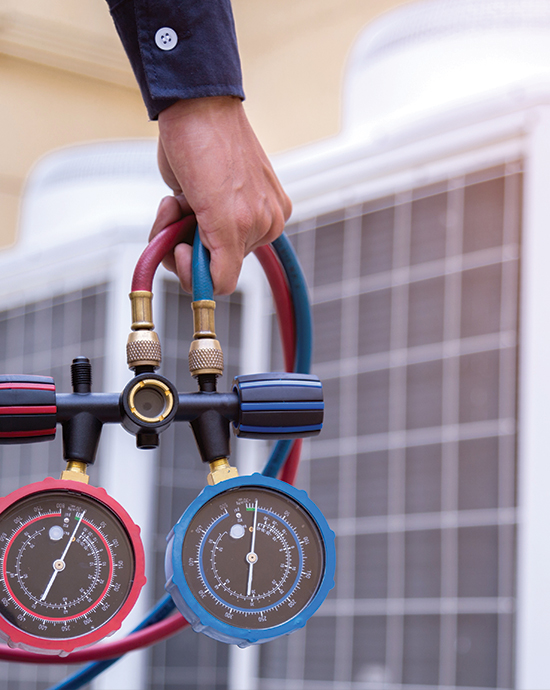As we approach 2025, the HVAC industry is undergoing a significant shift. Homeowners across the U.S. will soon need to adapt to a new set of refrigerant standards that prioritize environmental safety. This change, driven by the American Innovation and Manufacturing (AIM) Act, will phase down the use of hydrofluorocarbons (HFCs) in heating and cooling systems. As a homeowner, understanding these changes can help you make informed choices for your home’s heating, ventilation, and air conditioning (HVAC) systems.
Why Are Refrigerants Changing?
Historically, HFCs like R-410A have been widely used in residential and commercial air conditioning systems. These refrigerants are known for their high efficiency, but they also have a high Global Warming Potential (GWP). GWP measures how much heat a gas traps in the atmosphere compared to carbon dioxide. As climate awareness grows, reducing high-GWP gases is becoming a priority. The AIM Act, passed in 2020, mandates the gradual reduction of HFCs to more eco-friendly alternatives. The act aims to reduce the production and consumption of HFCs by 85% over the next 15 years.
For homeowners, this means that common refrigerants, such as R-410A, will be replaced by alternatives with a lower environmental impact, specifically lower-GWP options.
How Will the Refrigerant Change Affect Your HVAC System?
The switch to new refrigerants will bring several changes to HVAC systems, impacting new installations and possibly some existing systems. Here’s what homeowners can expect:
- New Equipment Requirements: After 2025, new air conditioning systems will be required to use the approved low-GWP refrigerants. While it may still be possible to service your existing unit with R-410A, many HVAC manufacturers are moving towards systems that are compatible with newer refrigerants.
- Impact on Repairs and Maintenance: As HFCs are phased out, R-410A will become harder to find and more expensive. If your current system uses R-410A, you may face higher costs for repairs or refrigerant replacements. This cost increase may make upgrading to a newer, low-GWP refrigerant system more appealing.
- Energy Efficiency and Cost Savings: Newer refrigerants are designed to be more energy-efficient, which can translate to lower energy bills over time. Though the initial cost of upgrading or installing a new system may seem high, the efficiency gains can help offset these costs.
What Are the New Refrigerants?
The refrigerants that will likely replace R-410A include R-32 and R-454B. These options have a much lower GWP, making them more environmentally friendly.
- R-32: Already in use in some countries, R-32 has a GWP that is significantly lower than R-410A. It is energy efficient and may be compatible with some existing system components, though it’s typically used in new systems.
- R-454B: This refrigerant is another low-GWP option gaining traction in the HVAC market. It is considered a close replacement for R-410A in terms of performance but with a much smaller environmental footprint.
Both refrigerants promise better energy efficiency, which could mean monthly savings on your utility bills.
Should Homeowners Upgrade Their HVAC Systems?
If you have an older HVAC system using R-410A or another HFC, now is a good time to consult with an HVAC professional about your options. While upgrading your system may require an upfront investment, it can offer several advantages, including:
- Improved Energy Efficiency: Newer refrigerants paired with updated HVAC technology can make your system more energy-efficient, potentially lowering utility bills.
- Reduced Environmental Impact: By choosing a system that uses low-GWP refrigerants, you’re actively reducing your carbon footprint.
- Future-Proofing Your Home: Upgrading now means you won’t face the challenges of maintaining an HFC-based system as these refrigerants become less available and more expensive.
How Boer Brothers Heating & Cooling Can Help
Boer Brothers Heating & Cooling is here to make the refrigerant transition as smooth as possible. Whether you’re considering an upgrade to a new system or simply want to understand the costs and benefits, our team can provide expert guidance on the best options for your home. We offer a range of services, from maintenance and repairs to new installations that comply with the latest refrigerant standards.
Our technicians are fully trained in handling low-GWP refrigerants and can walk you through your choices, helping you find an efficient, eco-friendly solution that fits your budget and home needs. We’ll ensure your home stays comfortable and up-to-date with the latest regulations.
Preparing for the Future of HVAC
The refrigerant change in 2025 marks a shift toward more sustainable practices in the HVAC industry, ultimately benefiting the environment. By staying informed and proactive, homeowners can make the most of this transition, securing a system that is both eco-friendly and cost-efficient.
Contact Boer Brothers Heating & Cooling to learn more about the upcoming refrigerant changes and how we can help you prepare for a greener, more efficient future in home comfort.

